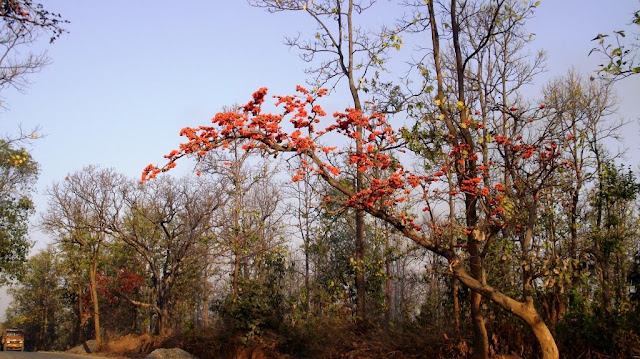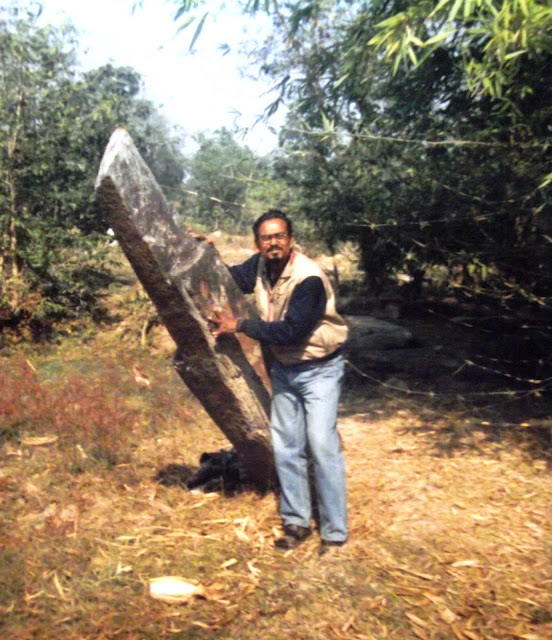Subhashis Das
Fig 1. Sketch of the Great Munda burial ground of Chokahatu by J.Scharamburg. The skecth show a Munda tribal siting beside a sansandiri dolmen. The Baranda Buru (hill) is visible in the background.
Credit: Journal of the Asiatic Society of Bengal. Vol 42 . 1873.
In Vol
42 Journal of the Asiatic Society of Bengal published in 1873, Col. E.T.Dalton, the then Commissioner of Chutia
Nagpur (present day Chotanagpur of Jharkhand) writes about the enormous
megalithic burial site of the Mundas in Chutia Nagpur called Chokahatu (Fig 1) of which he was informed by one T.F.Peppe. Dalton
further writes that arriving there “at
past noon” he “set all his clerks at
once...to count the slabs and to measure the area of the space which they
covered”. Counting revealed to him that there were about “...7360 tombs mostly of the dolmen or
cromlech form...” and the entire site which Dalton had sent his aides to
measure was spread to a whopping land area spanning more than seven “statutory” acres. Dalton informs that excavation of the site may reveal an
understratum of “similar graves”. But
what was astonishing was what Dalton saw there; the site despite being massive was
“...still used by the Mundas...” for
over two thousand years; this disclosure was
undeniably astounding which immediately tempted this author to journey to
Chokahatu.
To travel here I, the author
required more information about the site and about the route. Books of S.C.Roy,
M.G.Banerji and D.R.Patil do make scanty mention of the Chokahatu megalithic
site taken largely from Dalton’s write-up hence he could acquire no extra
information from these.
At the fag-end of the 90s I made a trip to the Great
Munda Burial of Chokahatu. Arriving at
Bundu from Ranchi a few villagers who were sentient of the site guided him to the
site. My visit to the megalithic site finds significant mention in one of my earlier books SACRED STONES IN INDIAN CIVILIZATION (with special reference to megaliths).
The term Chokahatu is austric Mundari in
origin which means “a place of mourning”;
this has lent its name to the village whose predominant population is yet that
of the austro asiatic Munda tribe.
The
megalithic site of Chokahatu in actuality is a burial ground of the Munda tribe
which in the austric Mundari speech
is called a hargarhi or a harsali etc that can be seen in every
tribal village of Jharkhand. The village and the burial ground of Chokahatu are
located between Buranda and Bundu. During the visit of Dalton these estates
were in the Lohardagga district or in the region of Chutia Nagpur (present Chotanagpur). The area then as
today was also known as the Panch Parganas or the five districts of the region
where the old panchparganiya language also known as the Kurmali language was spoken; which is
a blend of Nagpuri, Hindi, Bangla, Odiya, Mundari and Kurmali languages and that is
still prevalent among the residents of
here.
The Mundas narrate a story of their migration of
entering Jharkhand from outside more than 2800 years ago. The Munda
families and their clans after reaching here during the prehistoric times are
believed to have felled the woods in
the region to build their villages and acquire ownership of the land; a system
which they still identify as khuntkatti. The
Mundas, had brought their megalithism along with them into the land which is
now known as Jharkhand. However this Mundari migration lore has not yet been
scientifically testified.
The Panch
Parganiya region is believed to have been under the Jaina influence during the
Kharavelas and during the reign of the Nagavanshis, Brahmanism was wide spread
here. A fable quite popular among the natives is that Lord Shree Chaitanya who
had spearheaded the bhakti movement
in Bengal and Odisha was believed to have trekked from Puri to Varanasi through
this route thereby spreading the cult of kirtana
which is still popular across the region. Despite these Hindu influences several Mundas
have held on to their animism and megalith making.
For me, arriving
at Chokahatu for the first time was a jaw-dropping experience ;
standing in the middle of the site I found myself lost amid a sea of
innumerable burial stones. So massive is the site that once at the center it is
purely unfeasible to view its outer peripheries. If in 1873 Dalton found the land
area to be over 7 acres with approximately 8000 tombs, then today the size of
the burial ground must have augmented many a fold and the number of the megalithic
monuments too ought to have proportionately swelled as the Munda tribes even
today erect their megaliths there.
Fig 2. Large size burial slabs
Fig 3. A large sasandiri dolmen comprising of a large capstone that has been made to rest on 6 short heighted vertical orthostats.
Fig 4. A sasandiri dolmen resembling a table.
The local
non-Brahmanical paganstic/tribal priest known as “pahan” informed me that the megalithic burial ground was still being used by the Mundari tribes
not only of Chokahatu but nine of other contiguous villages who have their
areas allotted to them in the hargarhi since
hoary times. This phenomenon is also cited in Dalton's paper published in the Journal of the Asiatic Society of Bengal in 1873 The megalithic ground
comprises of large sized horizontal burial slabs (Fig 2) and dolmen like structures with out sized capstones supported by 4, 6 or 7 short horizontal
stone stands (Fig 3); many resembling tables (Fig 4), both known as sasandiris in the Mundari language.
Fig 5. I stoop over another table top sasandiri dolmen
No excavation of the site has
been conducted either by the Archaeological Survey of India or by the State
Archaeology Department. The “pahan”
informed me that after the cremation of the dead, his/her bones and ashes are
placed in an earthen pot which is buried at the allotted space of the
respective village in the megalithic site and on top of it the relevant sasandiris are erected or placed.
Several stone slabs and even the dolmen type sasandiris contain the bones and ashes of the dead members of the
same family. The larger and elaborate the grave stones, the more noteworthy the
position of the dead person may
have been in the prevalent society.
The megalithic tribes of
Jharkhand more or less practice the pot burial mode of entombment. Any other
type of burial which Chokahatu may hold could be revealed after an apposite
scientific excavation of the site. Such an exercise would also demonstrate its
hoariness by dating the antiquity of the megalithic tombs and their yields.
The quarry of the dolmens and the horizontal
burial slabs, many of which are very large in size and are of various irregular
forms seems to be the hills of Buranda and Hesadih Burus located few miles
to the due North and South respectively of the sacred burial ground of
Chokahatu.
Fig 6. I stand holding a birdiri menhir.
Since my last visit to Chokahatu I could spot only two menhirs (commemorative standing stones) known in the
Mundari vernacular as birdiri (Fig 6). According to the locals these menhirs
were implanted as boundary markers of the burial ground.
Fig 7. Few small sized cupules can be seen engraved in an irregular manner on this small semi-circular stone.
On a short inclined
raised stone with a semi-circular top about 20 small sized cupules can be seen
engraved in an irregular manner (Fig 7).
Cupules are one of the most enigmatic creations of the ancient peoples.
Although these small circular depressions have been elevated to the status of
rock art today, one does not categorically understand the purpose behind their
creation.
Fig 8. Within a bamboo grove in the eastern periphery of the megalithic site several modern day burial slabs and sasandiri dolmens could be viewed.
In the outlying eastern fringe
of the site is a bamboo grove into which several of these megaliths disappear.
The vicinity houses present-day dolmens and atop several of these capstones of
the smaller sized sasandiris are
epitaphs inscribed in Hindi of the dead persons (Fig 8). Standing there and observing the abundant
modern day megalithic tombs one would quiver in utter thrill; as being here is
like witnessing history in the making. Many
megalithic monuments of the site appear to have been erected at a hoary age and
a few seem to have freshly set up. In other words megaliths
are being made here unrelentingly till the present day for over 2000 years or
more making the Chokahatu megalithic site as an obvious contender for the
UNESCO’s World Heritage status.
Fig 8. I stand amidst a sea of burial slabs
Fig 9. I gaze at a small Stonehenge type sasandiri dolmen.
India despite being a treasure
house of megaliths cannot boast of a single megalithic site adorned with this
prestigious tag as that in countries like the UK and France. By the time of
writing this story Hire Benekal in Karnataka was declared as the only
megalithic site to be included into the 6 tentative lists of World Heritage
Status of 2021 India.
If Hire Benekal does get honoured with this status then
it would be the first megalithic site in India to be granted with this
prestigious label. It is a pity that the megalithic site of Chokahatu although
is a better claimant for the World Heritage Status for its continuous usage for
over 2000 years, the state government has not even been awarded it or any other
megalithic site in the state with a heritage grade.
A video on the Chokahatu megalithic site:











































